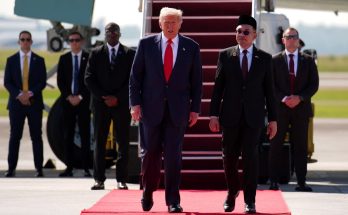 Indian elections are always a colourful affair. Fittingly, they have variously been billed as the world’s largest democratic exercise and the great Indian tamasha (circus). No matter what, few elections in the world are as raucous, multi-hued, and vibrant. And they rarely are without controversies. And the current ones are no exception. They can also be said to be one of India’s most polarised elections.
Indian elections are always a colourful affair. Fittingly, they have variously been billed as the world’s largest democratic exercise and the great Indian tamasha (circus). No matter what, few elections in the world are as raucous, multi-hued, and vibrant. And they rarely are without controversies. And the current ones are no exception. They can also be said to be one of India’s most polarised elections.
Pitting India’s grand old party – the Indian National Congress (INC) – against the right of centre Bharatiya Janata Party (BJP), with the usual regional players also in the fray, the current campaigning has taken on a more presidential style rather than a parliamentary one. The BJP’s prime ministerial candidate, Narendra Modi, has positioned himself as the development guru against the Congress’s more staid and younger Rahul Gandhi, the scion of the Ndhru-Gandhi family, which has been at the helm of governance since much of India’s independence. The BJP has made development and effective governance the main plank of its campaign. The Congress, mired in a number of scams, has chosen to focus on secularism, basing its attacks on the 2002 Gujarat riots in which more than a 1000 people died, a majority of them Muslims, and the controversial re-election of Modi who was chief minister of the state then. Predictably, it has also harped on the security of minorities in the country, especially Muslims, should Modi come to power. Trying to counter the BJP onslaught – as predicted by numerous opinion polls- the regional parties are also singing the same tune.
 But in this war of words and heightened rhetoric, what seems to be missing are the real issues. A cursory rerun of the last few days proves the point. A Congress leader in Punjab talked of “riots breaking out” in the country should Modi come to power. The leader of the Samajwadi Party, the regional party which is currently in charge of India’s most populous state Uttar Pradesh, promised to amend the Constitution in order to introduce reservations for Muslims. Not to be outdone, a member of the BJP in Bihar called for all those against Narendra Modi to relocate to Pakistan. While such rhetoric gains currency the impression created is that’s of its deliberateness in order to obfuscate issues of real concern to the electorate.
But in this war of words and heightened rhetoric, what seems to be missing are the real issues. A cursory rerun of the last few days proves the point. A Congress leader in Punjab talked of “riots breaking out” in the country should Modi come to power. The leader of the Samajwadi Party, the regional party which is currently in charge of India’s most populous state Uttar Pradesh, promised to amend the Constitution in order to introduce reservations for Muslims. Not to be outdone, a member of the BJP in Bihar called for all those against Narendra Modi to relocate to Pakistan. While such rhetoric gains currency the impression created is that’s of its deliberateness in order to obfuscate issues of real concern to the electorate.
And what are these issues?
In a remote village of Bundelkhand region, the 55-year-old Sungi Devi has to work for three months free of cost in the fields of the money-lender she borrowed money from to pay for the tonga ride she took to the distant village her daughter lived in when she passed away suddenly under mysterious circumstances. This kind of bonded labor persists in swathes of India’s hinterland. A recent report notes that India has one of the highest figures for human trafficking.
The statistics of deprivation are indeed grim. A World Bank report notes that almost 600 million Indians defecate in the open! India has one of the highest maternal mortality rates in the world. Besides, there are the perennial problems of unemployment, illiteracy, malnutrition, clean water, hygiene, sanitation. You name it and India has it.
 The creaky infrastructure-related problems are seen as being somewhat higher in the hierarchy of issues – considered problems mainly by city folks.
The creaky infrastructure-related problems are seen as being somewhat higher in the hierarchy of issues – considered problems mainly by city folks.
Climate change and foreign policy hardly enter the national consciousness and there has been hardly any meaningful public debate on these issues.
And all this sixty six years after independence!
Which explains the enormous desire for change that is sweeping through the country. The digital age, while enhancing the divide between the haves and have-nots, has simultaneously helped eliminate other barriers. Hence, people, especially the youth, sitting in cities and towns here are aware of how folks in other countries live. Since the benchmarks for us are usually those from the western world, the palpable impatience is understandable.
After all, it is significant that an entire generation is voting for the first time. And the mood in the country is clearly for change, for a different way of doing things, for a clean-up of politics and unleashing of the country’s enormous potential.
This all-pervasive mood of popular disillusionment is a direct fall-out of the massive corruption that has come to engulf Indian politics. Clearly, there is a huge anti-incumbency and a more empowered citizenry.
And, therefore, the issues that stare at much of the electorate renders the debate between secularism and communalism irrelevant. Not that secularism is not important. Indeed, a vast and diverse country like India can survive only through harmonious peaceful coexistence and an appreciation of this very diversity and pluralism. And that it in fact does so is obvious to any visitor who is struck by the heterogeneity of the country and the ability of its people to coexist amicably. Yes, riots happen. Though often instigated by politicians, they have almost always remained localised, rarely spreading beyond its immediate surroundings. And for every instance of communal friction there are far more instances of communal harmony.
But the real issues that people would like politicians to debate on is why, sixty six years after independence so little has changed for so many, and where they have, why this change has been marginally inclusive. The statistics of growth, impressive as they may be, do not matter much to those like Sungi Devi. Neither do the charges traded over secularism and communalism.
(The views expressed in this article are solely those of the author)
Author Profile
Latest entries
 DiplomacyJuly 21, 2015Arabs hold the key to defeating the Islamic State
DiplomacyJuly 21, 2015Arabs hold the key to defeating the Islamic State DiplomacyApril 26, 2014Hamas-Fatah reconciliation: What it means for peace in region
DiplomacyApril 26, 2014Hamas-Fatah reconciliation: What it means for peace in region India and the WorldApril 23, 2014Electoral battle rages on in India: But where are real issues?
India and the WorldApril 23, 2014Electoral battle rages on in India: But where are real issues? DiplomacyMarch 12, 2014India’s ‘Look Middle East’ policy poised for upswing
DiplomacyMarch 12, 2014India’s ‘Look Middle East’ policy poised for upswing







